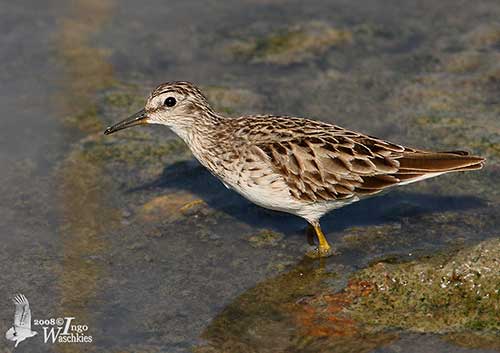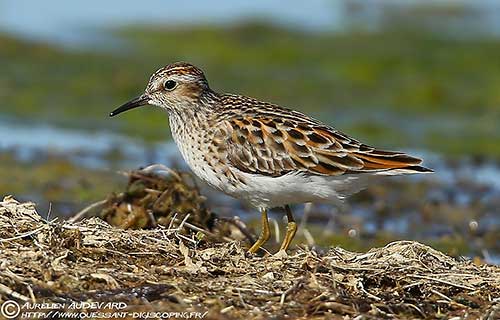
Fr: Bécasseau à longs doigts
Ang: Long-toed Stint
All: Langzehen-Strandläufer
Esp: Correlimos Dedilargo
Ita: Gambecchio minore
Nd: Taigastrandloper
Sd: långtåsnäppa
Photographers:
Aurélien Audevard
OUESSANT DIGISCOPING
Jean-Claude Jamoulle
A la rencontre des Oiseaux
Ingo Waschkies
Bird Photography
Text by Nicole Bouglouan
Sources:
HANDBOOK OF THE BIRDS OF THE WORLD Vol 3 by Josep del Hoyo-Andrew Elliott-Jordi Sargatal - Lynx Edicions - ISBN: 8487334202
SHOREBIRDS by Peter Hayman, John Marchant and Tony Prater – Christopher Helm – 1986 – ISBN: 0747014035
GUIDE DES LIMICOLES de D. Taylor - Delachaux et Niestlé - ISBN: 2603014080
THE HANDBOOK OF BIRD IDENTIFICATION FOR EUROPE AND THE WESTERN PALEARCTIC by Mark Beaman, Steve Madge - C. Helm - ISBN: 0713639601
What Bird-The ultimate Bird Guide (Mitchell Waite)
Wikipedia, the free encyclopaedia
Thai National Parks - Species of Thailand
Long-toed Stint
Calidris subminuta
Charadriiformes Order – Scolopacidae Family
INTRODUCTION:
The Long-toed Stint is very similar to the North American Least Sandpiper. The present species has fragmented breeding populations from SW Siberia to Kuril Islands. It migrates southwards to winter in a wide variety of wetland habitats.
As its name indicates, the Long-toed Stint has fairly long toes. This morphological feature allows the bird to forage in very wet soils where it probably walks on floating vegetation. This species nests in a shallow depression well hidden among the marshy vegetation.
The status of this species is poorly known, but currently, the Long-toed Stint is not globally threatened.
DESCRIPTION OF THE BIRD:
Biometrics:
Length: 13-15 cm
Wingspan: 26-35 cm
Weight: 20-37 g
The Long-toed Stint in breeding plumage has mantle and scapular’s feathers with blackish centres and rufous and pale buff fringes. There are some indistinct whitish lines at the edges of the mantle. Central rump and tail are dark brown, whereas sides of rump and uppertail are whitish, with grey tail’s sides. On the upperwings, the coverts are brown with buff and pale chestnut fringes. The tertials are broadly edged rufous. We can see a narrow white wingbar formed by the tips of the greater coverts.
The underparts are white, but the breast is washed grey-buff with dark streaking, especially on the sides.

On the head, the crown is streaked dark brown and rufous. The supercilium is whitish. The ear-coverts are rufous and there is a narrow, dark loral stripe. Nape and hindneck are paler brown with darker streaks.
The short bill is blackish but the base of the lower mandible is paler. The eyes are dark brown. Legs and feet vary from yellowish-brown to greenish-yellow or pale orange-yellow.
The toes, including the hind toe, are longer than on other stints, and the central toe is longer than the bill. They project beyond the tail during the flight.
Male and female are similar.
The Long-toed Stint in non-breeding plumage has dull grey-brown upperparts and white underparts, except for the breast still washed and streaked grey-brown. On the scapulars, the feathers have dark brown centres and paler fringes. The coverts have dark centres too.
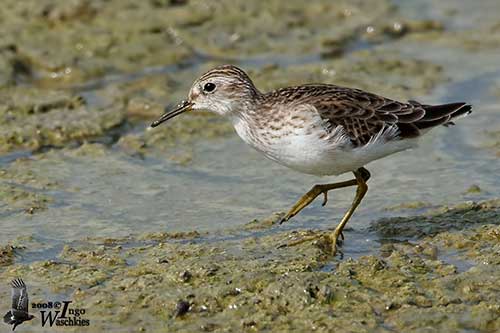
The juvenile resembles breeding adult but with finer streaks on the breast. The crown is dark brown with bright rufous streaks and the supercilium is broad and pale.
RANGE:
The Long-toed Stint breeds in Siberia during the North Hemisphere summer. The breeding range is very fragmented and includes Chukchi Peninsula, Koryak Plateau, Commander Islands, Kuril Islands, the area along the Sea of Okhotsk, N Verkhoyansky District and around the OB River and the Irtysh River.
After breeding, it migrates southwards to E India, Sri Lanka, and Indochina to Taiwan, and S to Philippines and Indonesia to W and SE Australia.
HABITAT:
The Long-toed Stint breeds in freshwater lakes, near pools in wet meadows among forest, and in damp, marshy tundra.
Outside this period, it frequents inland wetlands such as rice fields, freshwater or brackish pools, lakes, marshes, sewage farms and saltmarshes. It can be seen occasionally in sheltered tidal mudflats.
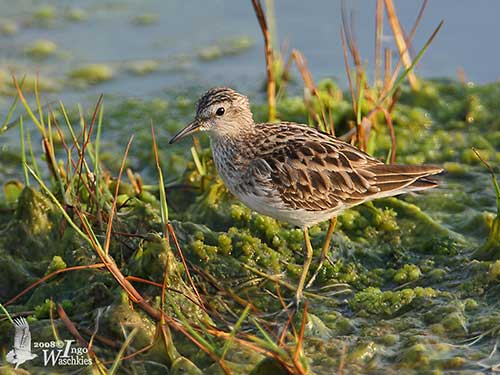
CALLS AND SONGS: SOUNDS BY XENO-CANTO
The Long-toed Stint gives short, soft, rippling “brrt-chrrup” or “chulip” that may recall the Curlew Sandpiper. We can also hear a sharp “tik-tik-tik”. The song is a slow “kroer” usually repeated.
BEHAVIOUR IN THE WILD:
The Long-toed Stint feeds on molluscs, crustaceans, amphibians, insects and other invertebrates. Some seeds are also consumed according to the season.
It forages singly or in small flocks of up to 50 individuals, among the vegetation at water’s edge, but also on floating aquatic plants, weeds or algae.
It probes the soil with the bill, and pecks active prey from the substrate.
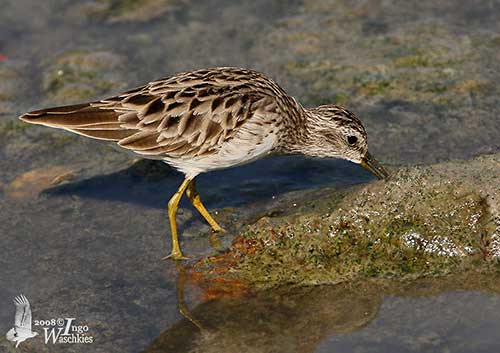
If alarmed, it stands upright with extended neck, but it also may crouch low when disturbed.
The Long-toed Stint breeds in June-July. It is probably monogamous. The courtship includes aerial displays, with the bird circling high in the air while singing.
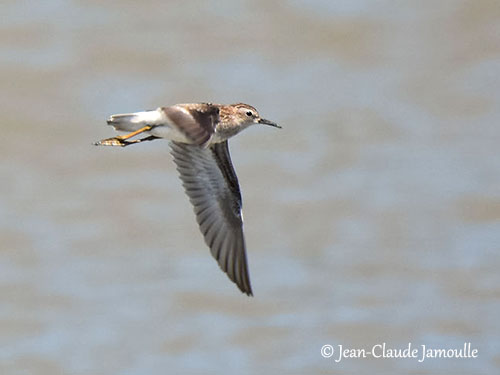
This species is migratory and moves southwards after the breeding season. During the spring migration, it may occur on Bering Sea islands and along Aleutian archipelago.
The Long-toed Stint has swift, direct flight with rapid wingbeats. However, the wingbeats may appear sometimes rather weak and fluttery.
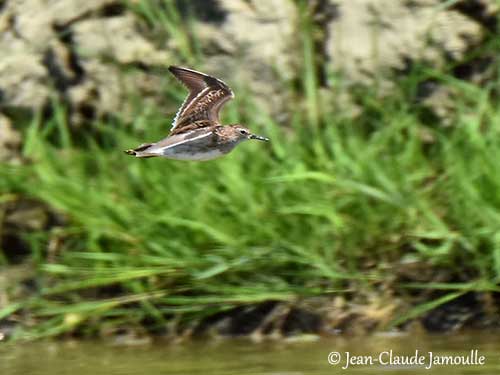
REPRODUCTION OF THIS SPECIES:
The Long-toed Stint breeds in June-July in boggy wetlands, near pools or in mountain tundra in taiga zone, up to 1,100 metres of elevation.
The nests are scattered but sometimes relatively close to each other. The nest is on the ground, a shallow scrape lined with grass and leaves. It is often built under a shrub near water.
The female lays 3-5, usually 3-4 eggs cryptically coloured. Both adults share the incubation during 18-22 days, but only the male tends the brood. No more information.
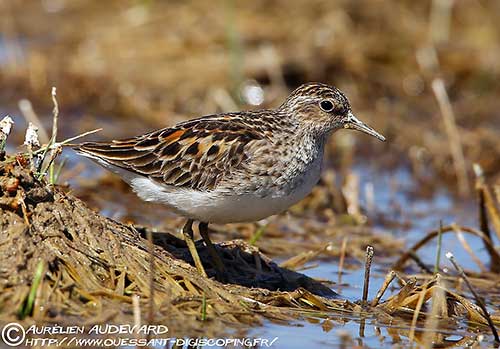
PROTECTION / THREATS / STATUS:
The Long-toed Stint is not globally threatened as no specific threats are identified.
The global population is roughly estimated to number more than 25,000 individuals (2006), but more information is needed.
The Long-toed Stint is currently evaluated as Least Concern.
